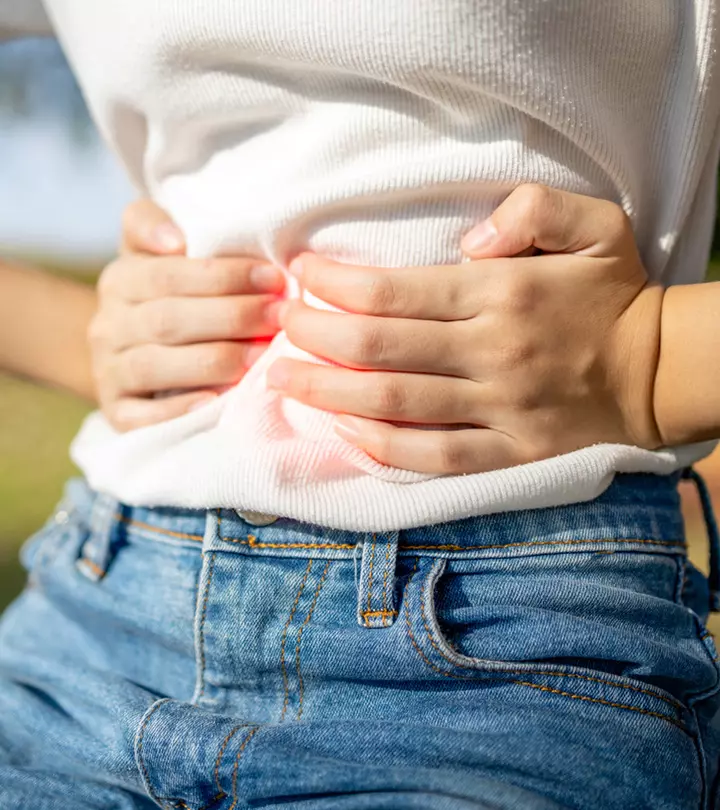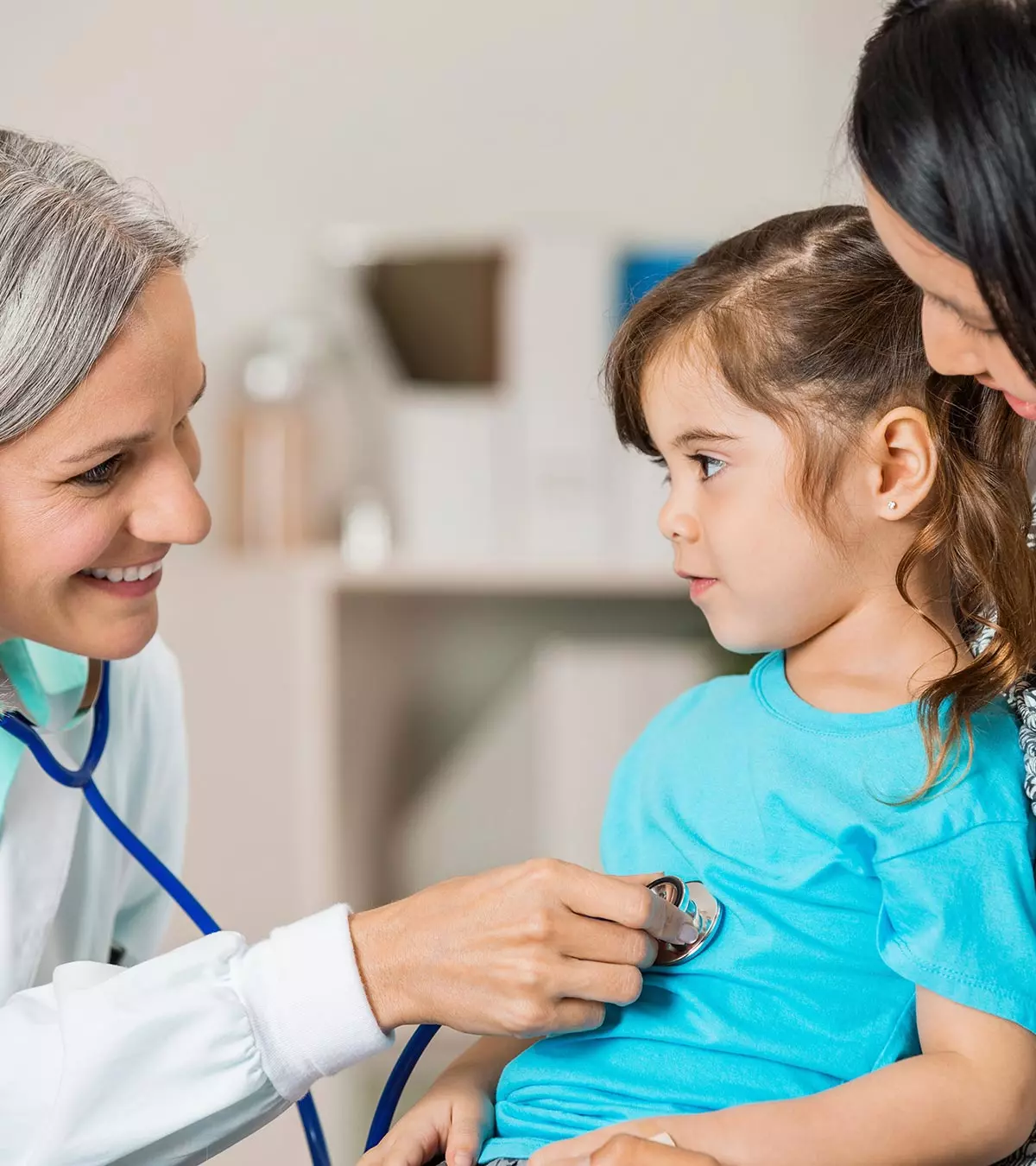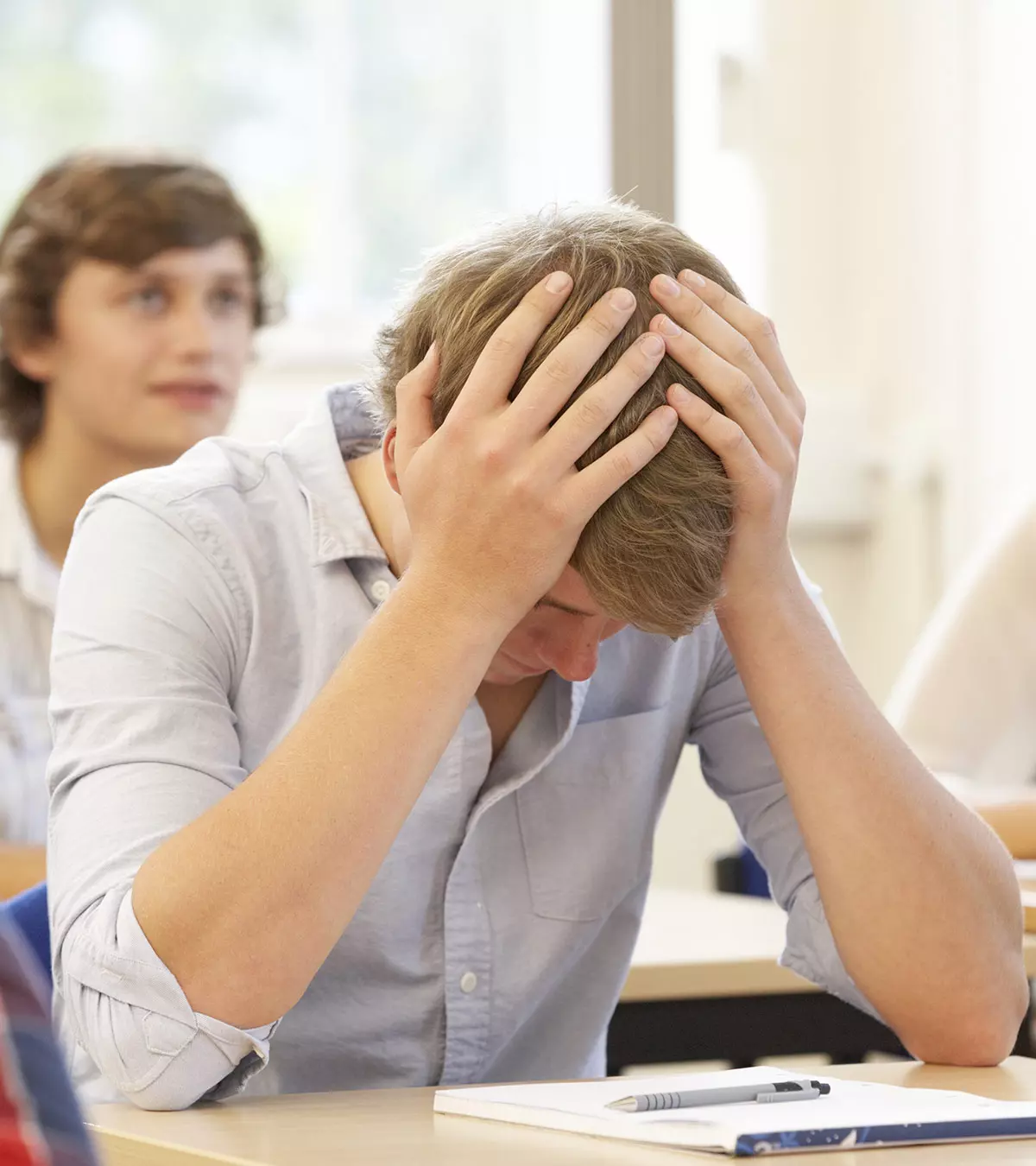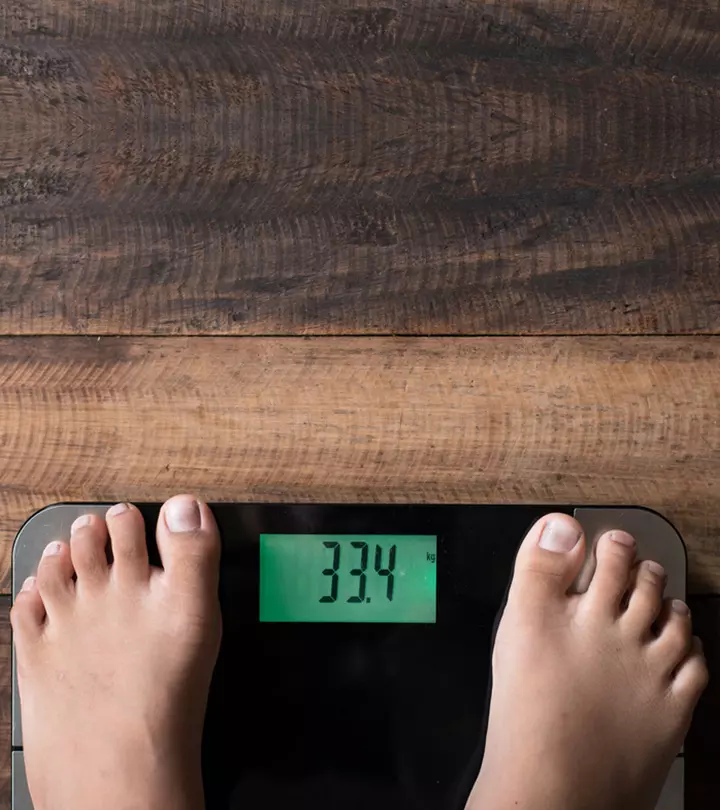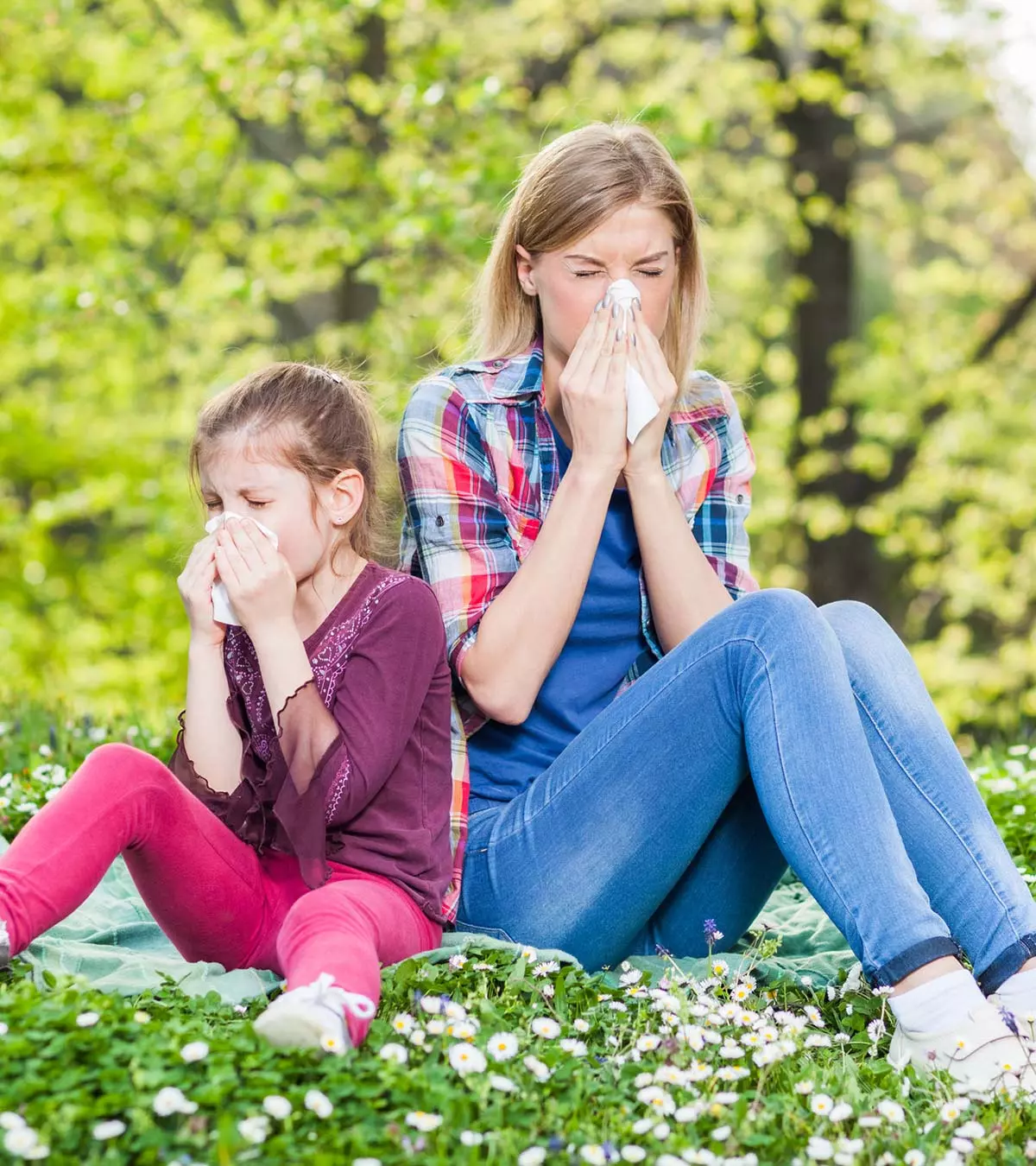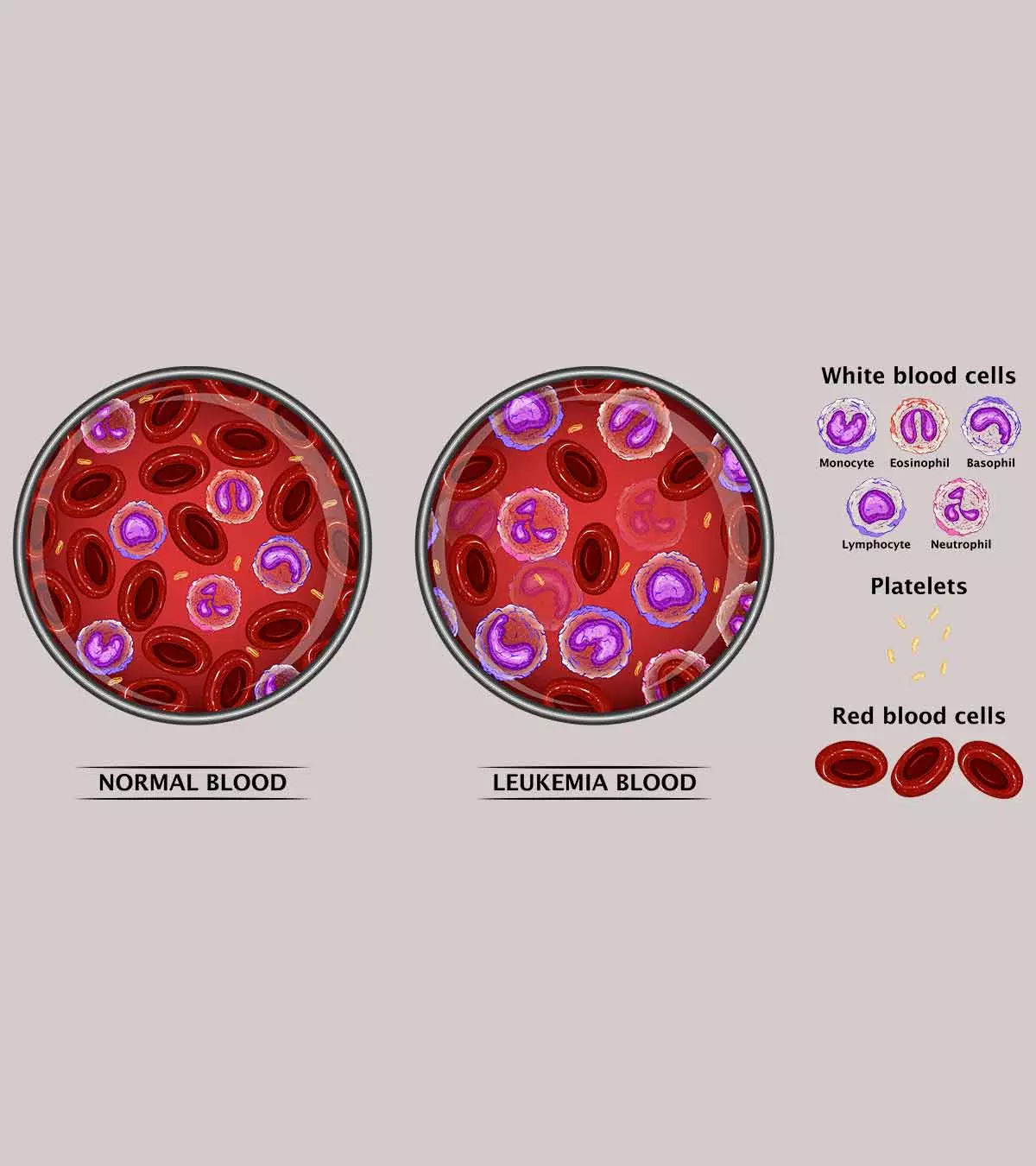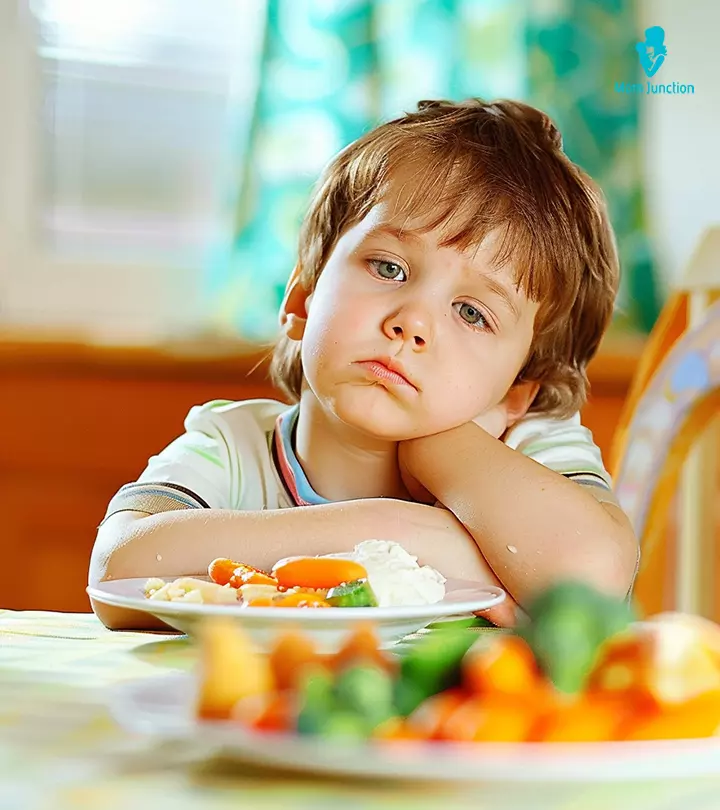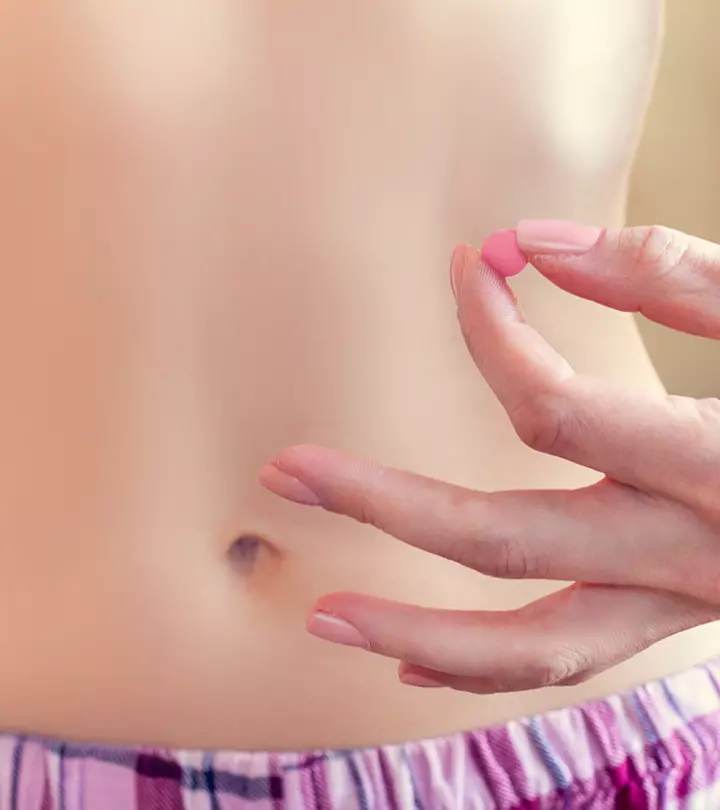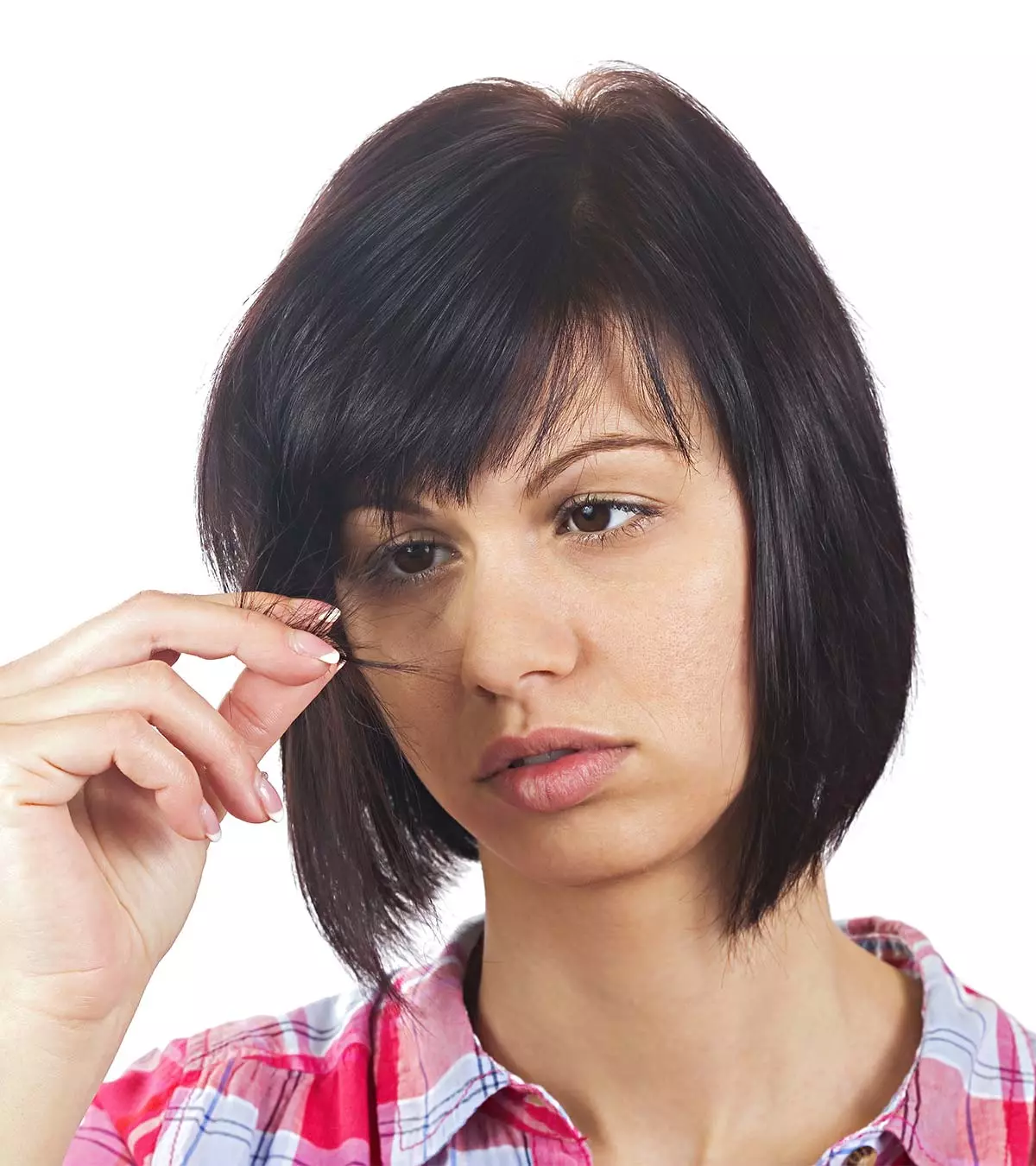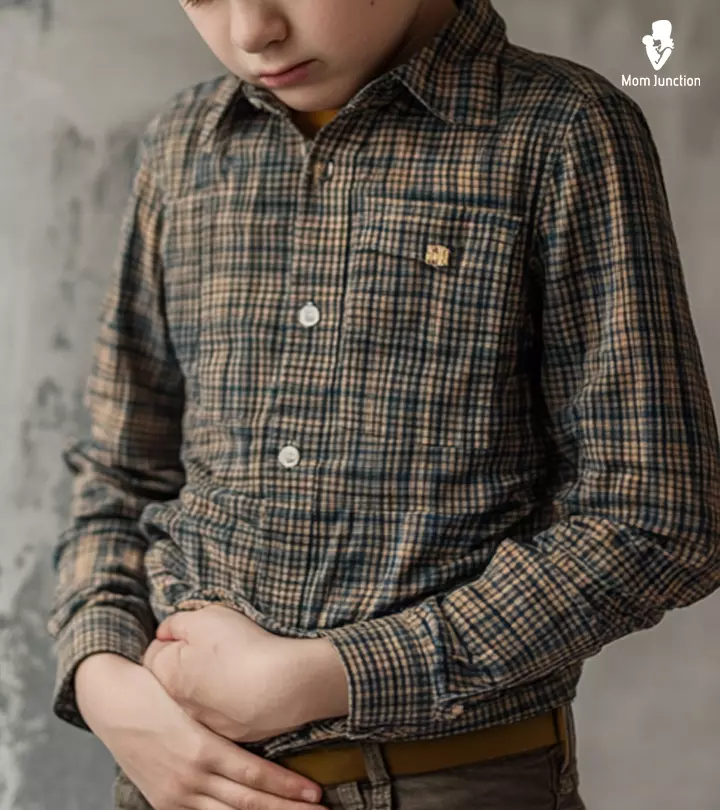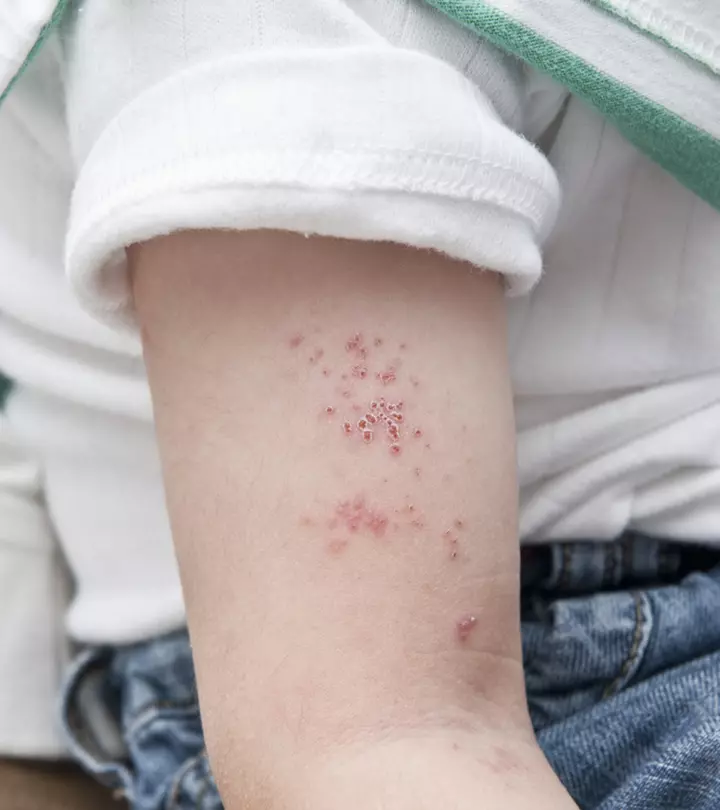
Image: Shutterstock
Shingles in children is a painful skin rash caused by the varicella-zoster virus.
It is the same virus responsible for chickenpox infection (1). The rash from shingles can appear anywhere on the body and can be extremely painful (2).
Herpes zoster affects more than one million people in the US each year. Around 30% or one in every three people develop shingles. Shingles are not common in children and are seen more commonly in people over 50. Read this post to learn about the causes, symptoms, diagnosis, treatment, and prevention of shingles in children (3).
Key Pointers
- The virus varicella-zoster causes Shingles in children, resulting in extremely painful rashes throughout the body.
- Children with a history of chickenpox before one year of age, maternal exposure to chickenpox, and a weak immune system are at higher risk of developing Shingles.
- Symptoms of Shingles in children include rashes, fever, fluid-filled blisters, and tingling pain.
- Treatment for Shingles in children depends on the severity of the condition, age, overall health, and specific symptoms.
Causes And Risk Factors Of Shingles In Children
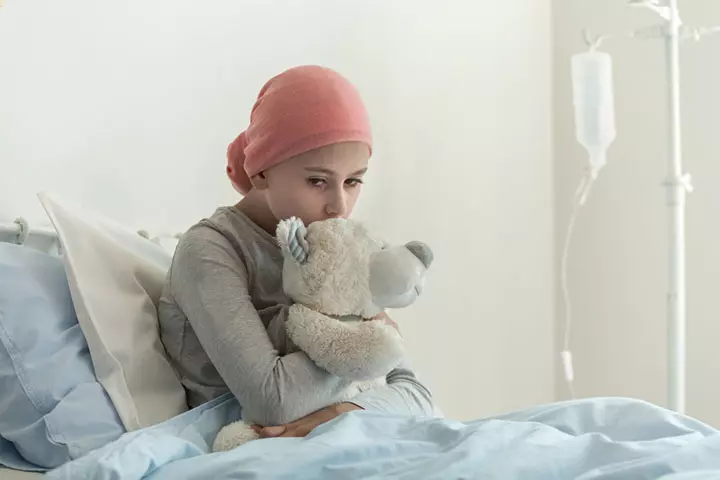
Image: Shutterstock
Once you have recovered from chickenpox, the virus may lie dormant in the body’s sensory nerves. The reactivation of the virus leads to shingles, also known as herpes zoster infection (3).
The following factors may put a child at a greater risk of developing shingles:
- Children who develop chickenpox before one year
- Mothers who develop chickenpox late in pregnancy
- Children with weakened immune systems
Children vaccinated against chickenpox are at a relatively lower risk for shingles when compared to a risk of re-infection after experiencing chickenpox
. In addition, the symptoms are milder in vaccinated children (4).
Symptoms Of Shingles In Children
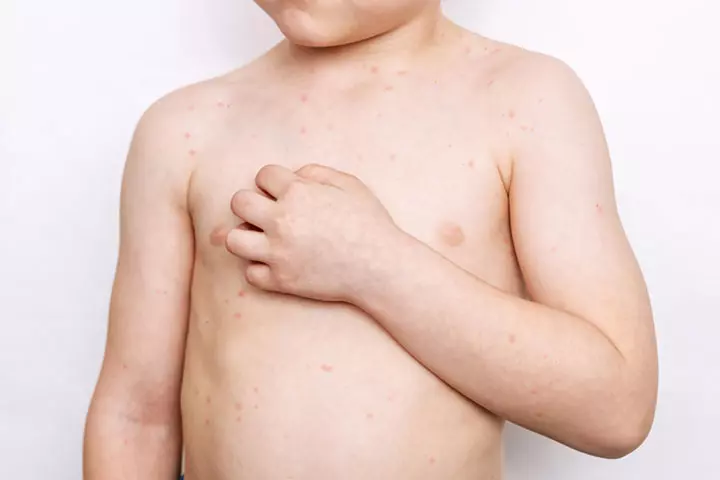
Image: Shutterstock
The infection causes small painful rashes or blisters on one small section on either side of the body. The blisters are more common on one side of the trunk or back but may also be seen on the face, legs, or arms. The following are the common symptoms of herpes zoster (3).
The blisters are more common on one side of the trunk or back but may also be seen on the face, legs, or arms. The following are the common symptoms of herpes zoster.
- Pain, numbness, burning, and tingling before the onset of rash and after the rash is cleared
- Fluid-filled blisters burst open, and scab formation occurs over them
- Rashes that cure within two to four weeks
- Fever accompanied by chills
- Headache
- Nausea
- Fatigue
- Sensitivity to light
The symptoms may vary from one person to another. Moreover, these symptoms may be similar to the symptoms of some other skin conditions. Consult your doctor if you notice any symptoms. However, seek medical care immediately if your child feels persistent pain and discomfort or their symptoms worsen.
In some cases, the pain continues for a prolonged period, even after the rash is gone. It is called postherpetic neuralgia (PHN). It occurs when nerve fibers in the skin get damaged, causing persistent pain even after the shingles rash heals. While most cases of shingles in children usually clear up on their own, PHN can bring about prolonged discomfort. However, it’s important to emphasize that PHN is relatively uncommon in children compared to adults.
Complications of shingles in children may also include vision problems if the rash is near the eye, potential skin infections due to the shingles rash, and, in rare cases, nervous system issues affecting facial nerves, hearing, balance, or, exceptionally rarely, leading to encephalitis (brain inflammation) (5).
Complications Of Shingles In Children
Rashes from shingles infection may get infected with bacteria and lead to a skin infection called cellulitis
. After the rash subsides, the pain may continue for a long time and cause discomfort in children. Therefore, seeking medical care and following up with the treatment is important to prevent or manage these complications early on, even if the rashes and symptoms subside. Consult your child’s doctor to get tips on pain management if such complications arise (4).
 Point to consider
Point to considerDiagnosis Of Shingles In Children

Image: Shutterstock
Diagnosis of shingles is mainly based on physical examination and a thorough medical history. In some cases, the doctor may use the following tests(3):
- Skin scrapings are collected and checked under a microscope for the presence of a virus that confirms shingles.
- Blood tests
Treatment For Shingles In Children
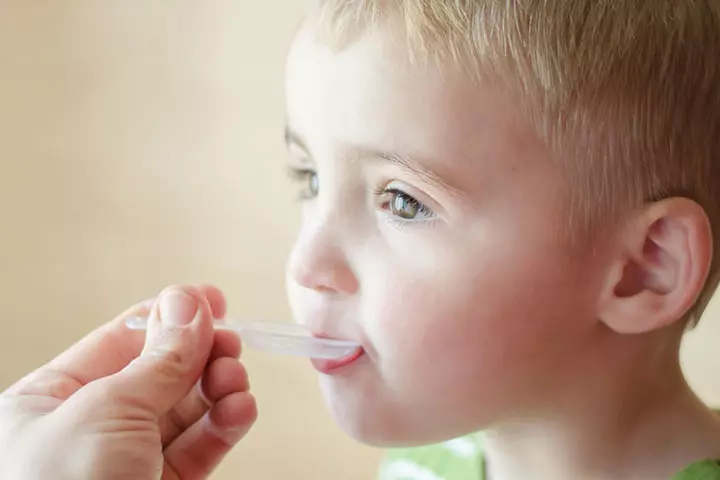
Image: Shutterstock
The treatment of shingles is dependent on the child’s symptoms, age, general health, and severity of the condition. Prompt treatment with antiviral medications reduces the symptoms’ severity and chances of developing long-term nerve pain (6).
The child may be prescribed acyclovir, famciclovir, or valacyclovir. These medications are only suggested when their benefits outweigh the risks.
You may check with the doctor regarding the safety of OTC painkillers for kids such as acetaminophen or ibuprofen for fever and pain. Avoid giving ibuprofen for kids younger than six months old without your doctor’s consent. Also, do not give aspirin as it may cause Reye syndrome (a rare but extremely serious complication). The doctor may prescribe strong pain medicine if the child has severe pain (4).
Home Remedies For Shingles
Home remedies can be an adjunct to the antiviral treatment and not a standalone mode of managing shingles infection
. Moreover, because these remedies are suggested based on anecdotal evidence, you should seek your doctor’s consent before trying them.
- Healing baths
Taking a cool bath or shower can provide relief for irritated skin and alleviate itching. An oatmeal bath or soaking in a tub filled with raw oats or ground oats powder can also help reduce the symptoms of skin irritation and itchiness. Avoid using hot water as it can further irritate the skin.
- Wet or cool compresses
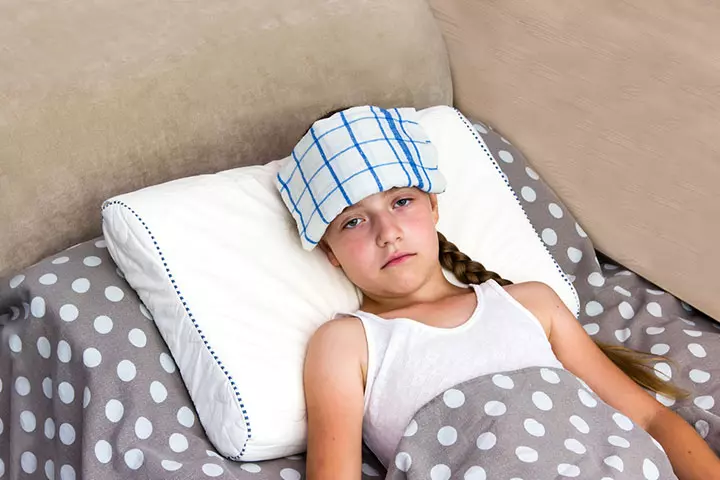
Image: Shutterstock
Applying a cool, moist compress several times a day helps relieve symptoms, especially the pain. Avoid applying ice as it may increase the pain and rashes.
- Baking soda or cornstarch paste
Mix two parts of soda or cornstarch with one part of water to make a paste. Apply it to the rash and wash off in 15-20 minutes. You may do it once or twice a day.
- Lotions and creams
Using mild and unscented lotions or cream can ease the discomfort. However, it does not speed up the healing process. Calamine lotions can also help in pain relief.
- Dietary remedies
Some foods that may promote healing by strengthening your immune system are orange and yellow fruits, leafy green vegetables such as spinach, red meat, eggs, chicken, fish, dairy, whole grains, legumes, beans, and tomatoes. Avoid foods containing high amounts of sugar, arginine-rich food, refined carbohydrates, and high-fat foods.
 Point to consider
Point to considerPrevention Of Shingles In Children
There is no shingles vaccination for children. However, if the child has not contracted a chickenpox infection, you can check with the doctor about administering the chickenpox vaccine for prevention purposes (4). You should also ensure proper nutrition for your child to strengthen their immunity.
Frequently Asked Questions
1. How long do the shingles last in children?
The rashes from shingles may take two to four weeks to resolve (4).
2. Can shingles cause hair loss in children?
Hair loss in children is not common due to shingles. Isolated cases of hair loss due to scarring from the rashes have been reported (7).
3. Can I put petroleum jelly on shingles?
You may apply a thin layer of pure petroleum jelly after cleaning the skin with a mild, fragrance-free cleanser and cover the rash with a sterile and non-stick bandage. Do this until the rash clears (8).
4. Can I use soap on shingles?
Yes, you may use mild soap to clean the skin affected by shingles (5).
5. How dangerous are shingles in a child?
Shingles can lead to vision loss, skin infections and neurological problems. For immunocompromised children, the infection may be life threatening (9) (10).
6. How contagious are shingles in kids?
One does not catch shingles infection from infected people. But, if you have never had chickenpox earlier, you may develop chickenpox upon coming in contact with someone who has shingles.
For those who have shingles, they are contagious until the last blister has dried and peeled (11).
Shingles do not occur in children who have not experienced chickenpox earlier. However, the varicella-zoster virus responsible for shingles may transmit chickenpox in them (12). Contact your child’s doctor if the symptoms worsen, do not improve, or develop other new symptoms (4).
Infographic: Management Of Shingles In Children
Shingles can be distressing and painful for children, leading to severe skin complications, such as cellulitis. While antiviral medications are recommended for the treatment, certain home care tips and remedies mentioned in the infographic below can also help alleviate symptoms and promote healing.
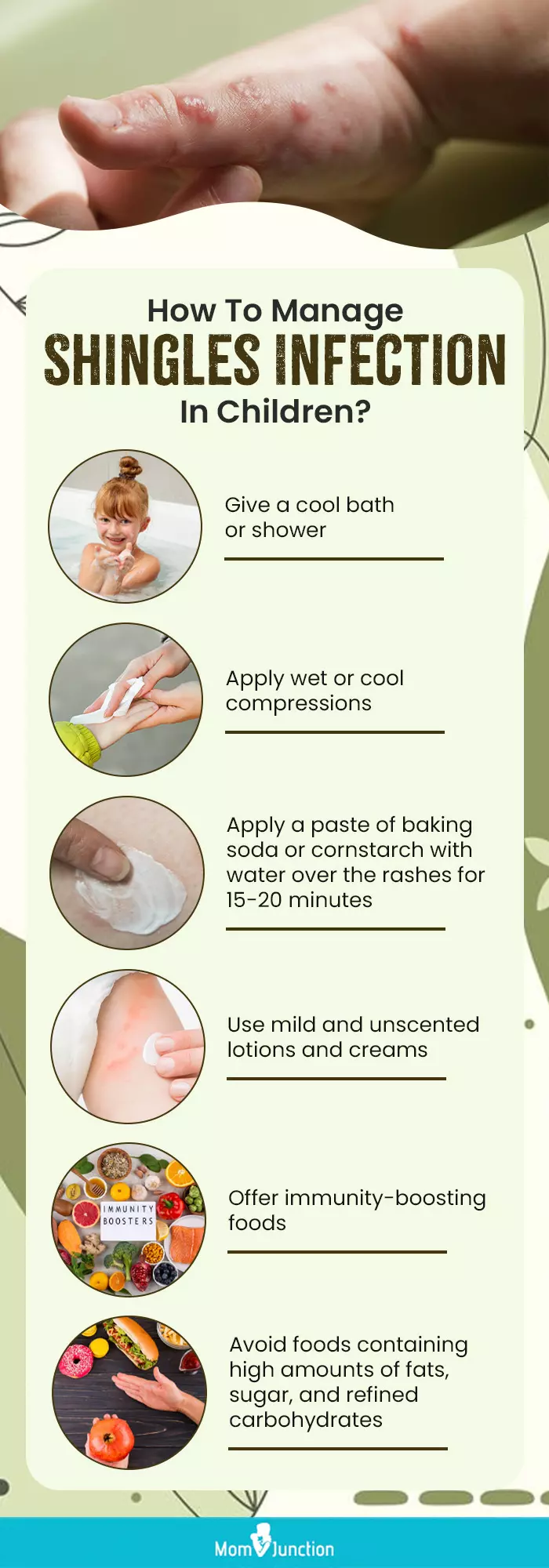
Illustration: Momjunction Design Team
Illustration: Shingles In Children: Is It Contagious Causes & Prevention
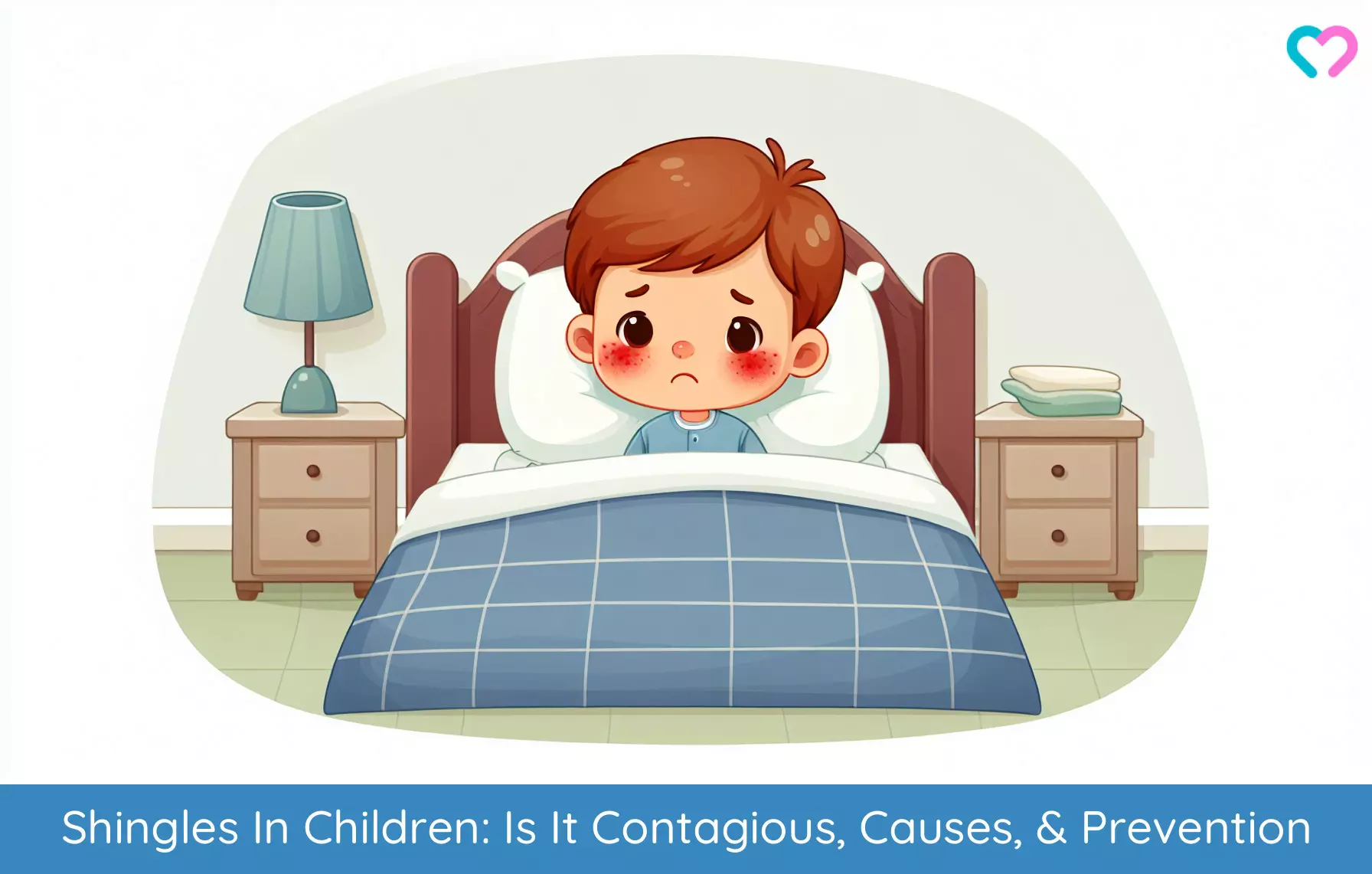
Image: Dall·E/MomJunction Design Team
Uncover the possible causes, symptoms, treatment and preventative measures for delaing with a skin condition such as Shingles, from a health professional.
References
- Shingles.
https://raisingchildren.net.au/guides/a-z-health-reference/shingles - Shingles in Children: Care Instructions.
https://healthy.kaiserpermanente.org/health-wellness/health-encyclopedia/he.shingles-in-children-care-instructions.bz1045 - Herpes Zoster (Shingles).
https://www.chop.edu/conditions-diseases/herpes-zoster-shingles - Pediatric Herpes Zoster (Shingles).
https://www.childrensnational.org/visit/conditions-and-treatments/skin-disorders/herpes-zoster-shingles - Shingles.
https://kidshealth.org/en/parents/shingles.html - SHINGLES: DIAGNOSIS AND TREATMENT.
https://www.aad.org/public/diseases/a-z/shingles-treatment - Lara El Hayderi et al.; (2013); Hair Loss after Varicella Zoster Virus Infection.
https://www.ncbi.nlm.nih.gov/pmc/articles/PMC3604874/ - SHINGLES: TIPS FOR MANAGING.
https://www.aad.org/public/diseases/a-z/shingles-self-care - Chickenpox shingles and vaccines: Expert shares what you need to know.
https://hscnews.usc.edu/chickenpox-shingles-and-vaccines-expert-shares-what-you-need-to-know - Varicella-Zoster.
https://pedclerk.uchicago.edu/ - Shingles
https://www.nhsinform.scot/illnesses-and-conditions/infections-and-poisoning/shingles - Can You Get Shingles if You Haven’t Had Chickenpox?
https://health.clevelandclinic.org/can-you-get-shingles-if-you-havent-had-chickenpox
Community Experiences
Join the conversation and become a part of our nurturing community! Share your stories, experiences, and insights to connect with fellow parents.
Read full bio of Dr. Elna Gibson
Read full bio of Dr. Ritika Shah
Read full bio of Rebecca Malachi
Read full bio of Vidya Tadapatri








